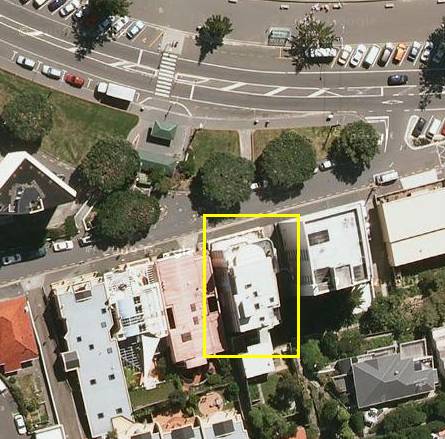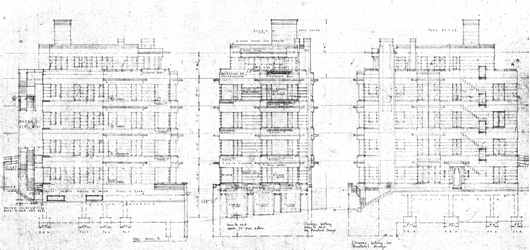Anscombe Flats
Unknown
-
Constructed
1937 - 1937
-
-
Architect(s)
-
Builder(s)
Unknown
-
Built in 1937 this building is a fine example of a Moderne style apartment building. It contains features such as the curved glass windows which were considered a technical achievement for their time.
The building is associated with Edmund Anscombe, an innovative and successful architect who embraced Moderne architecture and designed some of his best buildings in the idiom.
The building has townscape value for its distinctive architecture which sets it apart from the surrounding modern apartments. It is also visible from some parts of Oriental Parade.
-
Downloadable(s)
-
close
History
-
Anscombe Flats are named for Edmund Anscombe (1873-1948) one of New Zealand’s most distinguished 20th century architects. In 1933, at the age of 60, he bought a property on Oriental Parade and planned an apartment building to live in and rent out. He may well have had his mind on future retirement, although his greatest triumph, the Centennial Exhibition buildings, was still to come.
2007Reinstatement of conservatory roofSR67520 (& SR68857 2000)
Unknown dateReplacement of original windows in aluminium.
Plans for the building were prepared and the permit was granted in March 1937. Anscombe’s choice of Oriental Bay was noteworthy in that apartment blocks had begun appearing in the harbour side suburb from the 1920s onwards and the views and proximity of the beach would have been an attraction. Work on the building was completed before the end of the year. Anscombe occupied the top flat and may have used the attached penthouse as a studio. The rest of the floors were leased out. In 1940 the penthouse was converted into a self contained flat with a kitchen and bathroom and a housekeeper’s flat was built to the south of the building. Anscombe remained in the flat until his death in 1948. His wife had predeceased him and he was survived by two married daughters who presumably inherited the building, although their names do not appear on title transactions. Instead, the building was placed in the hands of their respective husbands, George Penlington and James Bennie, both architects in their own right, and solicitor Donald McIlroy in 1958, who most likely administered the estate.
In 1969 a private company, Anscombe Flats Ltd (the present owner), made up of the building’s tenants, bought the property. Each tenant acquired 28,900 shares in the company as part of their purchase of an apartment licence. Among those owner/tenants was George Amos (1890-1982), chairman of Soma-President Textiles Ltd, and a prominent Wellington community leader. Anscombe Flats Ltd. continues to own the building.
-
Modifications
close
-
1937
-
Residential apartments 00056:186:B16294
-
1940
-
Additions and alterations 00056:249:B20679
-
1997
-
Glass Balustrade to Penthouse SR36072
-
2000
-
replacement aluminium windows and doors to conservatory SR 66228
-
2001
-
External alterations to a heritage building SR76511
-
2007
-
Reinstatement of conservatory roof SR67520 (& SR68857 2000)
-
unknown
-
Unknown Date: Replacement of original windows in aluminium.
-
-
Occupation History
close
Not assessed
-
-
close
Architectural Information
-
Building Classification(s)
close
Not assessed
-
Architecture
close
The building is four storeys, one apartment per floor, with a penthouse above and basement parking / storage. The building is Moderne in style. Art Deco and Moderne styles had their origins in the 1925 Paris Exposition Internationale des Arts Decoratifs et Industriel Modernes. Moderne is essentially a style of clean, geometric lines with minimal ornamentation usually in the form of abstract motifs derived from plant forms, sharply defined zigzags, chevrons and sunbursts set against plane surfaces and Anscombe Apartments epitomise this style in both form and detail.
The building’s form is essentially simple but its rounded corners, generous window area with window hoods, horizontal fluting and use of sculptural effect speak of Anscombe’s mastery of shape and form in the genre. The custom made curved glass corner windows were technically difficult to achieve and were (and still are) expensive to produce. This shows that Anscombe Flats is a very high quality building.
There are few decorative elements, the horizontal layered banding of the surfaces provides the principal articulation to the facades. This streamlined, horizontal emphasis also reflects the influence of the “International Style” of Modernism that in turn was influenced by ocean liners of the time.
The effect is more Moderne than Art Deco. The semi-circular sun-room at the front of the penthouse is a flamboyant gesture on the roof but wholly in keeping with the building’s style and a fitting cap to the whole.
-
Materials
close
Reinforced concrete: Foundations, walls, floors, lift shaft, stairs & chimney. External works including retaining walls and stair
Brick: chimney
Breeze block: partitions
-
Setting
close
Anscombe Flats is located on Oriental Terrace, a road which branches off from Oriental Parade in a south-westerly direction. The building has views over Oriental Bay and the wider Wellington harbour. The building is situated between two modern apartment complexes, with the complex on its north eastern side being of a greater height. Although there are a series of apartment complexes along the length of Oriental Parade, the elevation of Oriental Terrace means that Anscombe Flats is still visible when viewed from the far western end and mid northern section of Oriental Parade.
-
Building Classification(s)
close
-
close
Cultural Value
Built in 1937 this building is a fine example of a Moderne style apartment building. It contains features such as the curved glass windows which were considered a technical achievement for their time.
The building is associated with Edmund Anscombe, an innovative and successful architect who embraced Moderne architecture and designed some of his best buildings in the idiom.
The building has townscape value for its distinctive architecture which sets it apart from the surrounding modern apartments. It is also visible from some parts of Oriental Parade.
-
Aesthetic Value
close
-
Architectural
Does the item have architectural or artistic value for characteristics that may include its design, style, era, form, scale, materials, colour, texture, patina of age, quality of space, craftsmanship, smells, and sounds?
Built in 1937 this building is a fine example of a Moderne style apartment building. It contains features such as the curved glass windows which were considered a technical achievement for their time.
-
Townscape
Does the item have townscape value for the part it plays in defining a space or street; providing visual interest; its role as a landmark; or the contribution it makes to the character and sense of place of Wellington?
The building has townscape value for its distinctive architecture which sets it apart from the surrounding modern apartments. It is also visible from some parts of Oriental Parade.
-
-
Historic Value
close
-
Association
Is the item associated with an important historic event, theme, pattern, phase, or activity?
The rise of the apartment building in Wellington began in the 1920s and the Oriental Bay area became a favoured location for such developments. Anscombe Flats was one of number built in the area during the first flush of development and its transformation continues to this day.
-
Association
Is the item associated with an important person, group, or organisation?
The building is associated with Edmund Anscombe, an innovative and successful architect who embraced Moderne architecture and designed some of his best buildings in the idiom.
-
- Scientific Value close
-
Social Value
close
-
Identity Sense Of Place Continuity
Is the item a focus of community, regional, or national identity? Does the item contribute to sense of place or continuity?
The building has had few intrusive modern alterations or additions and contributes to the sense of place and continuity of the Oriental Parade streetscape.
-
-
Level of Cultural Heritage Significance
close
-
Authentic
Does the item have authenticity or integrity because it retains significant fabric from the time of its construction or from later periods when important additions or modifications were carried out?
The building has retained a significant amount of its original external fabric, therefore it has authenticity.
-
Representative
Is the item a good example of the class it represents?
The building is a very good example of the Moderne style.
-
Importance
Is the item important for any of the above characteristics at a local, regional, national, or international level?
4.0References
-
-
Local / Regional / National / International Importance
close
Not assessed
-
Aesthetic Value
close
-
close
Site Detail
-
District Plan Number
12/ 214 (front and side facades)
-
Legal Description
LOT 1 DP 9855
-
Heritage New Zealand Listed
2/Historic Place 1333
-
Archaeological Site
Central City NZAA R27/270
-
Current Uses
unknown
-
Former Uses
unknown
-
Has building been funded
No
-
Funding Amount
Not applicable
-
Earthquake Prone Status
124 Notice
-
-
close
Additional Information
-
Sources
close
- 'Characteristic House Types – Seven Basic Styles.' From An Encyclopaedia of New Zealand. Edited by A. H. McLintock. Originally published in 1966. Te Ara - the Encyclopedia of New Zealand. Updated 22-Apr-09. Accessed 1 October 2012
- Kelly, Michael. ‘212 Oriental Parade: Anscombe Flats.’ Unpublished report prepared for Wellington City Council. 2001.
- Accessed 4 September 2012.
- Archives: ‘212 Oriental Parade, residential apartments.’ 09 March 1937. 00056:186:B16294.
- Archives: ‘212 Oriental Parade, additions and alterations.’ 02 July 1940. 00056:249:B20679.
- Wellington City Council Records: CT 312/19. Land Information New Zealand.
- Technical Documentation close
-
Footnotes
close
Not available
-
Sources
close
Last updated: 11/23/2016 9:12:43 PM



